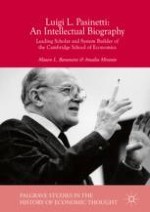2018 | OriginalPaper | Buchkapitel
7. Pasinetti on Post-Keynesian Income Distribution and Growth Theory: Further Developments
verfasst von : Mauro L. Baranzini, Amalia Mirante
Erschienen in: Luigi L. Pasinetti: An Intellectual Biography
Aktivieren Sie unsere intelligente Suche, um passende Fachinhalte oder Patente zu finden.
Wählen Sie Textabschnitte aus um mit Künstlicher Intelligenz passenden Patente zu finden. powered by
Markieren Sie Textabschnitte, um KI-gestützt weitere passende Inhalte zu finden. powered by
